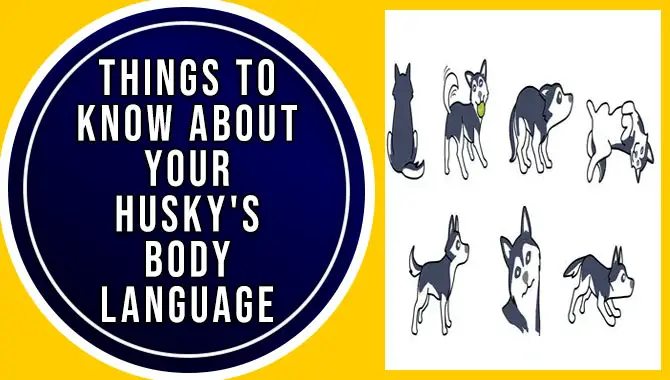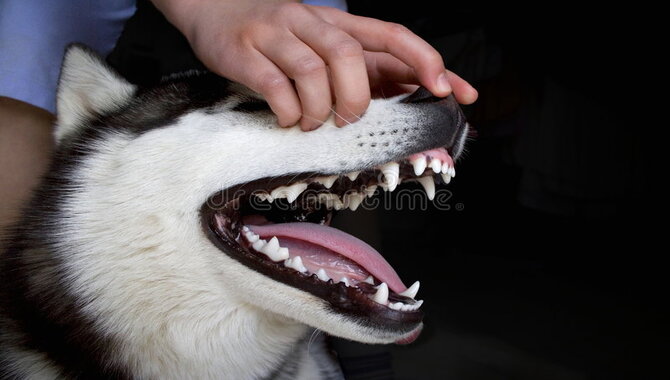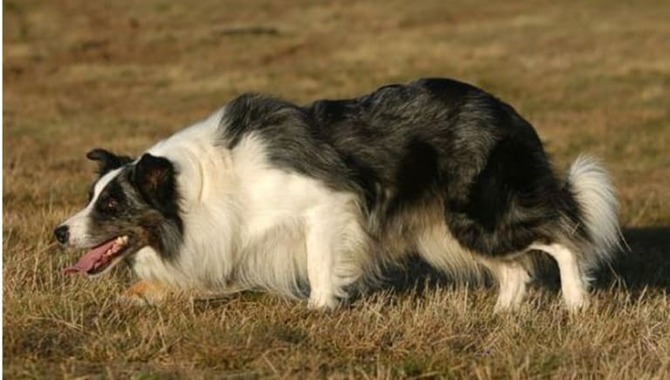As a husky owner, it is important to understand your dog’s body language to better communicate and bond with them. Huskies have a unique set of physical cues that can tell you a lot about their mood and behavior.
If you have a husky or any medium-sized dog breed, you are undoubtedly familiar with their body language. These dogs can convey countless messages with just one movement or posture.
Like humans, huskies’ body language indicates their moods, emotions, and mindset. As much as huskies love to play and be playful, they also love communicating with you. If your Husky seems upset or nervous around people or animals, they need to get the right signals from them.
If you notice that your Husky’s body language differs from what you expect, it could mean something’s off. We will talk about your pet’s body language signals, and you can read them to know what they mean.

Your Husky’s Body Language: Signs You Should Know About
Huskies are very expressive when it comes to body language. They can tell us their feelings through body language signs such as happiness, stress, fear, aggression, appeasement, play, and submission signals. The tail is also a part of husky body language.
The Husky’s emotions can relax, lower, or wag it. By observing husky body language, you will be able to understand your relationship with them better. Also, you can learn about the Husky’s mood by looking at its different body language signs.
For example, when a husky’s tail is held high and wagging, it usually makes them happy and excited. On the other hand, if their tail is tucked between their legs, it may indicate fear or anxiety. Other body language cues to look out for include ear position, eye contact, and overall posture. By paying attention to your Husky’s body language, you can better understand their needs and emotions, leading to a stronger and more fulfilling relationship with your furry friend.
1. Yawning: Appeasement Signal

Yawning has been observed in dogs as an appeasement signal, indicating that the dog feels uncomfortable or worried. People believe the dog yawns to calm itself down and help ease the situation. Studies have shown that yawning in dogs is contagious, meaning that when one dog yawns, other dogs are more likely to do so. Researchers have observed that dogs yawn in response to human yawns, suggesting that the behavior may be a form of empathy.
Yawning is a sign of contentedness in dogs and can indicate satisfaction with their environment. A dog yawning typically shows signs of stress, such as panting or pacing, which explains why it has historically been viewed as a sign of weakness in canine society. However, recent studies have shown that yawing can be used as a powerful appeasement signal and calming behavior, especially when a dog feels threatened or anxious.
2. Jerking Off The Tail: A Sign Of Excitement
Huskies can jerk their tails as a sign of excitement. They usually see this sign during play or when happy and excited. It is usually accompanied by a slowly wagging tail that you can hold in a high or neutral position. The upper fangs of the Husky may be visible, but the face remains relatively smooth. Mad huskies may wag their tails in a slow, consistent motion and hold their tails straight out stiffly.
This tail-jerking sign of excitement should not be confused with other signs of aggression, as it is a natural response to excitement. However, it is important to understand this behavior to ensure safety and prevent unwanted behaviors from developing. Overall, huskies are loving and affectionate dogs that display many body language behaviors when expressing their emotions and relationships with others.
3. Apparent Fangs, Wrinkled Face, And Closed Mouth

Husky body language can be a wired thing to understand. It’s hard to tell what’s going on inside a husky’s head, so it’s always helpful to have some signals to look for is always helpful. One of huskies’ most obvious body language signs in huskies is their apparent fangs and open mouth.
This is often a sign of aggression and anxiety, as huskies are known for being aggressive and protective animals. If challenged or threatened, a husky will also show signs of attack by wrinkling its face or growling. Understanding these signals can help you better relate with your dog and reduce the stress and tension in your relationship.
4. Exposed Fangs, Wrinkled Faces, And Open Mouth
Husky body language can be an important indicator of how the dog is feeling. These signals are especially helpful to understand when interacting with the dog in a public setting, such as at a dog park or show. Exposed fangs, wrinkled face, and open mouth signal that a Husky is feeling threatened and is ready to defend itself.
Other signs of submission and appeasement body language include ears against their head, tight mouth with a slight grin, slight crouch, licking at air or lips, lifting paw, and rolling over to expose their stomach. Understanding a Husky’s body language can help to better relate with the dog and know how to respond appropriately in public.
Tilting their heads and ears forward, tenser body language and tail wagging unusually are signs of dominance and readiness to assert themselves. By understanding these signals from a Husky’s body language, you can better understand its mood and interact with it more comfortably in public settings.
5. Looks Away: Appeasement Signal
Huskies often signal submission by averting their gaze. This behavior is often seen as a sign of deference or subordination in husky culture. When you see your Husky looking away, it is important to understand the implications of this behavior and how you can interpret it.
A Husky may show submissiveness by averting its gaze, but this behavior can also be interpreted as a sign of fear or aggression. Understanding the intent behind this behavior is essential to ensure it is used appropriately and not out of submission. If you notice your Husky looking away, it’s important to remember that this isn’t always a sign of submission and, instead, may merely be a warning signal.
6. Turns His Head Away: Signal Of Appeasement.
Husky body language can be useful for dog owners who want to understand their dogs’ moods and emotions. One of the most common body language behaviors seen in huskies is their tendency to turn their heads away when feeling threatened or angry. This behavior, known as ‘head-turning away’ or ‘turning the head away,’ is often accompanied by a tense body posture and a low growl.
If you see your Husky turn his head away from you in a threatening or aggressive manner, it is important to take action and remove him from the situation. If this behavior continues and becomes problematic, consider getting a dog protection fence to protect your Husky from predators and other harmful situations.
7. The Front Of The Body Lowered And Behind Raised: Call To Play
Dogs use body language, such as lowering the front of their body and raising their backside to invite others to play with them. This posture indicates that the dog is playful and wants to engage in social activities. Dogs may also use this posture to entice another animal to follow them. By lowering the front of the body and raising their backside, dogs signal that they are open to interaction.
Other animals may respond by approaching the dog, which allows for playful interactions. When dogs use this posture to invite play, you can extend it to humans and other animals. Thus, dogs use body language to communicate their intentions and emotions, making them able to form close relationships with people and other species.
8. Gives The Paw / Puts The Paw On You
Your Husky may give the paw as a sign of appeasement when their head is down, to the side, and looking away. Hand-holding may signify affection and trust when a Husky gently takes your hand in its mouth. A Husky may also offer their paw to gain attention from their owner.
The action of lying on your back can be a sign of submission from the dog, indicating that they are giving up and asking for comfort. Observing your Husky’s body language is important to help understand their behavior and develop relationships with them over time.
9. Licks Another Dog’s Mouth
Dogs licking each other’s mouths can be a sign of submission, usually done with the head down. It can also signify submission after a confrontation or a dogfight. Once one dog has won the fight, it is common for them to lick the mouth of the loser, which indicates acceptance of the other’s dominance.
This behavior often occurs as appeasement signals, showing that no harm was intended and to soothe or calm down the other dog. Sometimes, lip-licking can be a calming signal to show that no harm was intended. Dogs looking away or turning their heads away from another dog during an interaction can also be appeasement signals. When dogs lip-lick each other’s mouths, it is often out of affection and to express friendliness toward each other.
10. Walks Slowly Have Slow Movements (Normal Position): Appeasement Signal.
Dogs may slow their movements when approaching another dog or person to calm the situation. Dogs call this behavior appeasement, a common sign of submission and submission signals. When nervous, fearful, or reactive, dogs may stop moving or sit down until the situation calms down.
In some cases, dogs may start moving again only after the situation has calmed down. Yawning may also be an appeasement signal during a tense situation, often seen in nervous dogs and showing submission signals. Sighing, growling, and snarling are aggressive behaviors that an anxious dog may exhibit.
11. Walks Slowly Have Slow Movements (Low Position): Hunting.

When hunting, dogs may move slowly and lower their body position to better stalk and capture their prey. This low body position allows the dog to remain hidden and undetected by their prey. It also helps the dog to remain calm and focused on its task of capturing its target.
Typically, a dog will move slowly while hunting, crouch, or freeze completely to avoid detection. By moving slowly and keeping a low body position while hunting, breed dogs can easily avoid drawing attention to themselves and stay focused on the task at hand. When fearful or anxious, a dog may crouch, roll onto its side or back, or freeze completely to avoid the situation.
12. Puts His Head On Another Dog’s Back: A Sign Of Dominance
Placing the head on another dog’s back is subject to interpretation as a sign of dominance. This behavior is often seen in dogs when asserting their place in the hierarchy and showing off their position. This behavior is not necessarily a sexual one; rather, it is an instinctual behavior that is deeply rooted in their genes.
It can be used to show an appeasement signal and to avoid a confrontation. Such behaviors are often seen among dogs in the wild, who use such signals to establish or maintain social hierarchies and keep the peace within the pack. In some cases, however, placing the head on another dog’s back can signify submission or submissive behavior.
What Does Your Husky’s Body Language Mean?
A husky’s body language can tell you much about its emotions and state of mind. When the Husky is happy, it may tilt its head and ears forward, exposing its neck. People often associate this behavior with happiness, excitement, or eagerness.
Huskies are known for their expressive and communicative body language. Understanding your Husky’s body language can help you better understand their needs and emotions. Here are some common husky body language signals:
- Tail position: A high tail indicates excitement or alertness, while a tucked tail can indicate fear or anxiety.
- Ears: Perked ears signal attentiveness and curiosity, while flattened ears may indicate fear or submission.
- Eye contact: Direct eye contact can signify dominance or aggression, while avoiding eye contact may indicate fear or discomfort.
- Body posture: A relaxed, loose posture indicates contentment, while tense muscles and a stiff body suggest anxiety or fear.
By paying attention to your Husky’s body language cues, you can build a stronger bond with your furry friend and ensure that they feel safe and comfortable in their environment.
What To Do If Your Dog Is Acting Out Of Character?
The Siberian Husky is a versatile breed that works well in many environments, including the Arctic. It’s also a popular choice as a sledge dog due to its strength and endurance. Siberian Huskies are active, strong, and durable dogs that can hold their own in the cold. They’re curious and intelligent, making them a good choice for families with children.
There may be a reason why your dog is acting out of character; there may be a reason. It’s important to recognize the signs of aggression and fear in your Husky so you can help him feel comfortable and submissive. For example, dogs exhibiting aggressive body language or behaviors may try to assert dominance or show fear.
You can avoid issuing threats, such as making direct eye contact or staring at them, making your husky feel threatened. Instead, you should pay attention to your Husky and show him affection while supervising his interactions with other people and animals. If your Husky starts acting aggressively, you should correct his behavior immediately. Look for signs of stress, submissiveness, or fearfulness to help determine your Husky’s best course of action.
Conclusion
Husky is a compact, energetic dog known for its loyalty and high drive to chase and hunt. These traits are useful for hunting but can be challenging to manage. Your Husky’s body language signals alert you to possible danger or distress.
In addition, it tells you if your Husky is happy, scared, angry, or seeking attention. Learn the body language signals to read your Husky’s mood and better understand his thoughts and actions. Your Husky’s body language is quite a helpful tool in understanding how your dog would react to certain situations.
Use this knowledge to help you understand what motivates him, and you’ll be able to get the most out of your Husky. We’ve covered your Husky’s body language, and body language is a reliable way of gauging your Husky’s moods. So the next time he’s acting out of character, try these simple body language signals.
Frequently Asked Questions
[rank_math_rich_snippet id=”s-b9b0ada5-457b-4d73-a538-ddec5733e34e”]